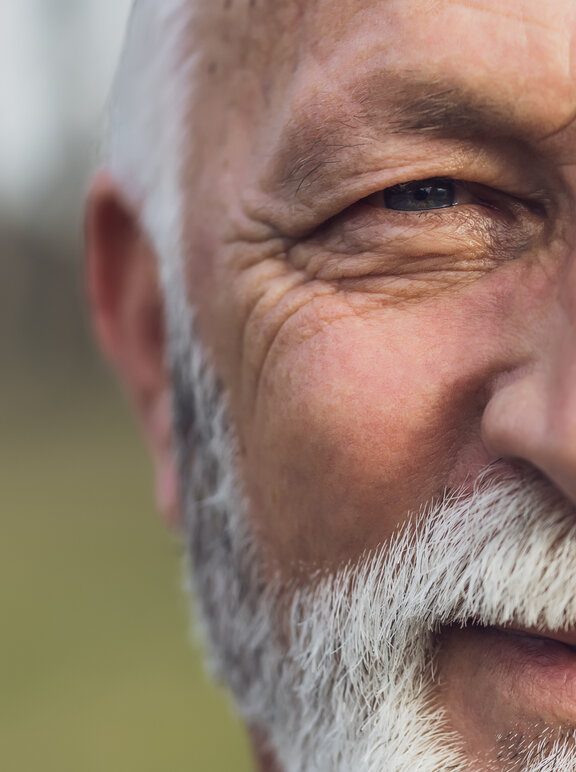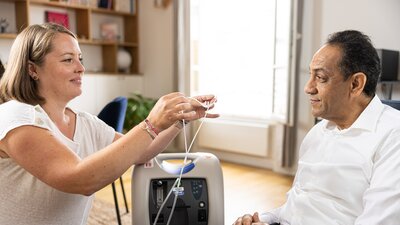Treating chronic diseases: motivational interviewing, the key to adherence
Published on April 15, 2022

Listening, talking, questioning, motivating… to take better care of ourselves. When treating a chronic disease such as sleep apnea, training in the use of medical devices, understanding the treatment and remembering best practices are not always enough for optimal adherence. Through a medical study in collaboration with the La Princesa university hospital in Madrid, Spain, Air Liquide Healthcare provides a new solution based on emotional intelligence. This approach, which is heavily focused on the patient and uses a personal approach, allows them to take control of their treatment and to adhere to it better in their everyday lives.
Treating sleep apnea
Sleep apnea — or OSAHS (obstructive sleep apnea hypopnea syndrome) — is one of the most common sleep-related breathing disorders. In its mild and severe forms, sleep apnea affects 6–17% of the adult population, particularly men, with an increasing prevalence with increasing age1. It is caused by the pharynx muscles relaxing during sleep, thereby obstructing the airways. The brain then reacts by triggering a brief, unconscious awakening to resume breathing. The health impacts are immediate: fatigue, daytime sleepiness, headaches, and memory and concentration issues. In the long-term, untreated OSAHS increases the risk of cardiovascular diseases, road traffic accidents and accidents at work, and it can significantly alter the quality of life of the patient and those around them.
Once diagnosed, CPAP (continuous positive airway pressure) is the standard treatment2 for both mild and severe OSAHS. If used well, it quickly improves daytime sleepiness and its impacts on everyday life. However, "daily application of this therapy requires a motivated patient profile, as lack of adherence is the main problem with this therapy" states a recent study3 by pulmonologists from the La Princesa university hospital (Madrid, Spain) and Air Liquide Healthcare teams in Spain.

“My father also suffers from sleep apnea and he follows the same therapy as me. I am very happy because these interviews have helped both of us to find answers to any doubts, questions and worries that we have had about the treatment.
”
Personal motivation, a deciding factor
This is where the interest in new strategies, such as the MEntA behavioral approach, comes in. During a motivational interview conducted by a specially trained nurse, each patient is invited to express their feelings, doubts and hopes about the treatment. It is a non-judgmental, empathetic discussion adapted to suit each person. This approach is all the more relevant given that previous studies4 have already shown the impact of a patient’s social context on their adherence.
For example, married and retired patients have a higher adherence rate compared to those who live alone and/or work. By taking this personal environment into account, the motivational interview helps patients to solidify their determination and anticipate risks and reasons as to why they may stop following the treatment, so that they can deal with them better. Rather than trying to convince them, the goal is to identify and stimulate the desire for change and recovery.
After 90 days of treatment, the 42 patients who participated in a motivational interview achieved an average adherence rate of 6 hours per night, compared to the 4.4 hours achieved by those (41) who followed the standard theoretical training, focused on using the device. “This is possibly the main benefit of the motivational interview, since it allows the involvement of the patient who adheres to the therapy from a different perspective: not because it is a prescribed treatment, but because he is motivated” highlights the researchers, who are opening up this “broad field of study” in healthcare.
These efforts have been supported by Air Liquide for 30 years, with the ambition of understanding what really matters to patients and providing them with answers to improve their quality of life. Out of the 1.8 million people worldwide cared for by Air Liquide in 2021, 38% already follow a personalized care program. Based on valued healthcare principles, this approach is further supported by the commitment of Air Liquide Healthcare to the entire healthcare field, patients, professionals, institutions and paying authorities.
Obstructive sleep apnea is caused by an obstruction of the upper airways, resulting from the collapse (closure) of the pharynx. During sleep, the muscles in this area become less tense, and, in people with an anatomical predisposition, this can result in a pharyngeal obstruction. This closure, which lasts for at least 10 seconds5, is either complete (apnea) or partial (hypopnea). In both cases, it can lead to a gradual decline in blood oxygen levels and an increase in carbon dioxide levels. The patient wakes up to activate their muscles and reopen their airways. If these brief awakenings happen between 15 and 30 times an hour, it is referred to as mild OSAHS, whereas in severe cases, they happen over 30 times an hour.

“These interviews encourage us to stay motivated and positive about the therapy, even though it’s a complicated process.
”
2. Haute Autorité de santé (French National Authority for Health) “Comment prescrire les dispositifs médicaux de traitement du syndrome d’apnées hypopnées obstructives du sommeil chez l’adulte” (How to prescribe medical devices to treat obstructive sleep apnea hypopnea syndrome in adults)
3. Rudilla D, Landete P, Zamora E, Román A, Vergara I, Ancochea J. Read the article in the medical journal Open Respiratory Archives “MEntA Program Based on Motivational Interview to Improve Adherence to Treatment of Obstructive Sleep Apnea With Continuous Positive Airway Pressure (CPAP): A Randomized Controlled Trial”.
4. Gagnadoux F et al. PLoS One 2011. "Influence of marital status and employment status on long-term adherence with continuous positive airway pressure in sleep apnea patients".
5. Inserm "Apnée du sommeil: Une source de fatigue, mais aussi de maladies cardiovasculaires" (Sleep apnea: A cause of tiredness, but also cardiovascular diseases)


